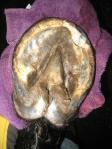Kristy Athens's Blog, page 12
December 16, 2012
Guest Post: On the Relocation Road
Helen Hiebert is one of my oldest friends in Portland (not that she is old—our friendship is!). We met because we had a friend in common who makes paper, and so does Helen—in fact, she teaches, lectures and exhibits her work internationally, and is the author of the books Playing With Paper, Papermaking with Plants, The Papermaker’s Companion, and Paper Illuminated. Helen is the vice president of the International Association of Hand Papermakers and Paper Artists and a regular contributor to Hand Papermaking Newsletter. Visit her website at http://www.helenhiebertstudio.com.
On the Relocation Road
By Helen Hiebert
My family and I moved to a resort town in Colorado (not exactly the country) in August. It isn’t something we really planned on doing, and although I like the idea of living on the land, I was not sure that it is something I would be well suited for. This is due to the fact that I am an artist, and running my own business keeps me busy enough (not to mention the family: two kids, a husband and a puppy).
We’d been living in Portland, Oregon, for the past 14 years and both of our children (and puppy) were born there. My husband Ted got a job offer in Avon, Colorado (where Beaver Creek Ski Vacation Resort is located), late last spring, and after weighing the pros and cons, it seemed like we should try it for two reasons:
We’d debated between Colorado and Oregon when we left New York City in the 1990s in search of a place to start our family.
It seemed like a good idea for one of us to have a stable income and benefits (Ted has been a freelance writer).
So, after a whirlwind visit in June (when we visited a few towns and saw a few schools) we decided to move.
Many decisions followed: Should we sell or rent our house in Portland? (We sold it.) Which school should we send our kids to? (We chose a charter school with an expeditionary learning philosophy, which has been okay so far, although different states have different learning standards, which has proven a challenge for our kids.) Where should we live? Ted moved out a month before we did and found a nice rental house in Eagle Vail (10 miles west of Vail and 2 miles east of Beaver Creek) that is within walking distance of the kids’ school.
So we’re settled, for now at least. But there is still the dilemma of when and where to buy a home here. That is, if we can afford to. Our rent here is double what our Portland mortgage, and homes in our price range are 10 to 30 miles away, which is another school district! But aside from the high rent, there are many perks to staying here: our rent actually includes most of our utilities (which can be steep in the winter; think “heat”); we don’t have a yard to tend to (no pitchforks in sight!); the kids can walk to school; so far we’ve managed with just one car (though there have been several conflicts); and we live between two of the nation’s premiere ski resorts!
In order to thrive here (while socking away a bit of money to help the kids go to college, pay for our retirement, etc.), I need to pull my weight in income. Thankfully, I’ve had a few projects lined up this year, including my newest book, Playing With Paper, which will be in stores January 1, 2013. I also travel to teach and lecture, which worked out pretty well when Ted was freelancing. Now that he has a full-time job, this has proven more difficult to coordinate with the kid’s schedules, especially since the Denver airport is two hours away.
A woman who was entering my information into the kids’ school database sent me a fan email after looking me up online. We got together, and she ended up offering to share her studio space with me in an old schoolhouse in Red Cliff (elevation 8,600 ft.; population 266). Talk about serendipity! We’ve split the space down the middle, literally. I cut out the carpet on my side so that I can get the floor wet. It is a bit awkward adjusting to a new space (I really liked my detached garage space in Portland), but I trust that things will continue to work out. I just have to be patient and let them unfold as they will.
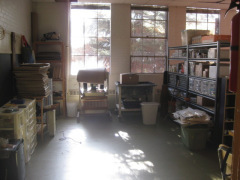
Helen’s studio in Portland
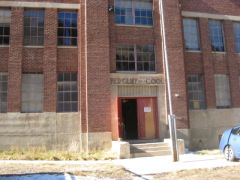
The schoolhouse in Red Cliff!

December 9, 2012
¡Fire in the Barn!
Our barn was beautiful. It had a good shape; it was nicely weathered. It perched on the edge of the level building site and loomed over the lower third of our land, which dropped quickly toward the White Salmon River. People took their pictures in front of it when they visited. A woman my spouse knew, named Alicia, even wanted to shoot a music video there in the summer of 2009 for a band called The Builders and the Butchers.
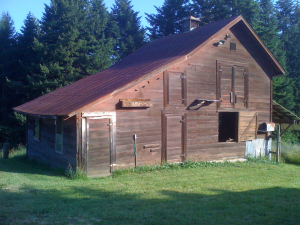
Picturesque in the morning sun!
The sticky part was that we’d already accepted an offer on our place—we were moving out in just a couple of weeks. But we liked the band, so we agreed. Mike told them, “You can do anything you want; just don’t burn down the barn.” This was no idle proviso: summer’s crispy-dry conditions and strong winds necessitated an annual burn-ban in our county. This meant no open flame of any kind.
The shoot was a serious affair—costuming, props, food services and the whole shebang! Our urban guests were considerate but did not appreciate the gravity of the fire situation. One spark from those leaky, antique kerosene lanterns would have leveled the barn, the fields and possibly the entire valley in minutes. I liked the band’s music but had never met them personally. They were all dressed up like gothic gangsters and looked pretty formidable.
On a post-shoot walkabout on Saturday, Mike and I found cigarette butts in the field. I didn’t sleep very well that night, racked with anxiety. The next morning, there was a stern all-staff meeting before shooting could resume.
In the end, nothing burned down. During the scene in the barn in which they’re starting to fight and the lantern wobbles a bit on the table, I shudder, but it all worked out. Some behind-the-scenes side notes:
When the fellas are entering the barn, there are ten chickens roosting just off camera.
I have to hand it to the Vivian Girls (in the yellow dresses) for sprinting up the hill toward the barn—it was really steep!
The duckweed-encrusted pond near which that troll lives is the one I talk about a few times in Get Your Pitchfork On!—the one that once held trout and that was threatening to flood during our springtime “water events.”
I’m glad we invited them out, because it gave us a chance to get to know the members of the band and of the production crew, many of whom are still friends! I hope it doesn’t ruin The Builders’ reputation as badasses to say that they are super-nice guys. Here’s the video; enjoy a peek at our old barn!
December 2, 2012
Celebrating 40 Years of The Encyclopedia of Country Living
Long before ever stepping foot on the seven acres my husband and I ended up buying in the Columbia River Gorge, we were armchair back-to-the-landers. While improving my gardening skills in backyard beds in the city, my primary go-to books were Barbara Damrosch’s The Garden Primer and Carla Emery’s The Encyclopedia of Country Living. Carla’s book was particularly loved—not only was it chock-full of information, but her writing style and personality were infectious. Dozens of times, I would go to look up a specific thing and end up reading for a half-hour.
The Encyclopedia of Country Living was a major influence when I decided to write Get Your Pitchfork On!. At first, I had no intention of trying to compete with it, or the dozens of other back-to-the-land books. But once my husband and I actually moved to the country, I realized that there were 21st-century gaps in Carla’s book. There were also swaths that were quaint but unnecessary, unless one were really signing up for primitive living. Which we were not.
None of this diminished my respect and love for The Encyclopedia of Country Living. And I’m not alone. The Internet is home to hundreds of tributes to Carla, from both before and after her death in 2005. It pains me that I never got to meet her.
However, I have the good fortune of knowing someone who did—Roberta Dyer, co-owner of Broadway Books in Portland, Oregon.
Carla began her publishing legacy in the early 1970s with a notice in the back of country-life magazines, advertising An Old-Fashioned Recipe Book. She immediately received responses and was a little taken aback because, well, she hadn’t written the book yet. She sent her investors the part she had written with a promise that she would continue to send chapters as she finished them. And so The Encyclopedia of Country Living (its eventual title) began—as a serial publication.
Carla typed out the manuscript and mimeographed the pages at her dining room table. Each chapter was printed on a different color of paper. She bound it with plastic-coated copper wire. Her friends would come over and help her hand-collate the monstrous editions.
Roberta met Carla because Carla had filled her family’s station wagon with thousands of mimeographed, hand-collated and -bound copies of An Old-Fashioned Recipe Book and started driving around the country, trying to sell them and get on television. At the time, Roberta was a book buyer for the popular retail chain, J.K. Gill. When Carla arrived her office, Roberta wasn’t sure what to make of her.
“She was all country,” Roberta recalls. “She practically had a calico dress on.”
While it wasn’t an act, Carla was media-savvy. She had gone to graduate school in New York before meeting her first husband, Mike, and moving to Idaho with him to start a homestead and a family. She brought her kids to promote her book. She once drove a goat (pygmy, I can only assume) to New York and, Roberta heard, sat in front of Gene Shalit’s office at The Today Show and refused to leave until he would talk to her. He did.
“I was impressed with [the book] because it was this thick!” Roberta holds her finger and thumb far apart. “It contained every tiny little bit of country-living advice that she had experienced; she just wrote everything down. She did her laundry in a washtub in the back yard! She was so tenacious.”
J.K. Gill carried the handmade copies, with their purple ink and mimeograph smell and copper-wire bindings. Roberta referred to her copy when she was canning and, like I have, found herself reading the stories.
Because the book was written in so many stages, it covers a vast swath of her adult life. In some sections she has two children, in some seven. In some she and Mike are working together on a project. In some, she has divorced him.
On our land, I referred to Carla’s book every time I turned around. How do I build a gate? How do I grow rutabagas? When a quail flew into our patio door and died, I whipped open The Encyclopedia of Country Living to figure out how to dress it.

There are still quail feathers in our copy!
I wrote myself notes so I would remember specifics in addition to her advice.
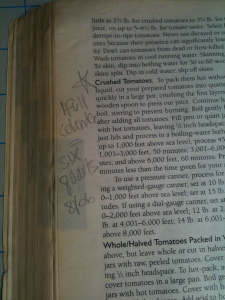
Notes for canning tomatoes
“[Carla] made me think differently about things,” Roberta says, “like she didn’t believe in washing clothes very much, and she sort of welcomed hard work.”
Every once in a while, Carla would return to J.K. Gill with her long hair and her outdated dresses to sell more books. This was a time when hippies were prevalent, so having long hair was not that outlandish. But Carla was not a hippie; she was a pioneer.
“I think [the book] was picked up by Bantam because it was the popular thing, the back-to-the-land movement, but she was not after that herself,” says Roberta. “They sort of turned her into a goddess of that movement, but it wasn’t her interest. She was very practical.”
After three years of entrepreneurship, Carla had a proper publisher; now she could go back to Idaho and live her life instead of marketing it. But there was no denying its momentum. Bantam printed 200,000 copies from 1977 to 1981 in six print runs.
Even a published book has a life of its own; Carla was constantly negotiating with first Bantam, and then Sasquatch Books, about rewrites, indexing and illustrations. She welcomed feedback from her readers, and even included much of their input in subsequent editions.
As time went on and Carla’s audience grew, she never lost sight of what made her happy—self-sufficiency on the land.
“I was born and raised in a small town,” says Roberta. “[Carla] was the genuine article.”
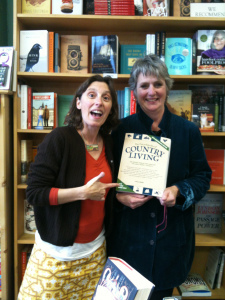
Kristy, Roberta and Carla at Broadway Books


November 22, 2012
Unadulterated Thanks
I understand the sentiments of people who refute Thanksgiving. There is no denying the devastation that invaders from Europe wreaked on North American natives over the past 500 years. However, to me, Thanksgiving is a beacon of hope.
I think it’s unfair to wrap the entirety of the genocide and displacement of Native Americans up with Thanksgiving. Conquering foreign territory was not unique to European culture at that time in human history. There were even warring Indian tribes across the United States. The myth of the “noble savage” does as much damage as ignoring our shared history. Native Americans are not magical nature pixies; they are human beings with the same gifts and flaws as any other humans.
The feast that occurred in 1621 is not well documented. Maybe the Indians and the colonists shared food that day, and maybe they didn’t. But let’s say they did. Let’s say they were nice to each other, and honored each other’s cultures. Things may have gone horribly wrong from there, but let’s just hold that day in our hands.
There are subsequent massacres of Native Americans for which the Puritans had Thanksgiving feasts. But let’s just keep Thanksgiving simple. Modern Americans rush around, physically and symbolically, all year; let’s honor Thanksgiving for the opportunity it provides to slow down and share a meal together.
Americans should recognize the brutal and unfortunate history of European domination and massacre in North America every day of the year, not just on Thanksgiving. It should be addressed not with guilt and derision but with amends, and equity in legislation and business practices. Thanksgiving can be a time to sneer at everyone and mutter “Thankstaking Day.” Or, it can be an opportunity to recognize the problematic legacy we have in the United States and also enjoy the Earth’s bounty and be thankful for one’s family and friends.

November 18, 2012
Grasping for Heritage
I feel an affinity with a parcel of land in Illinois that I have never seen and probably never will. This 90 acres was purchased by my great-great grandparents, Jacob and Margaret Eberle, in 1900 or so. When they died, ownership was split between their children, including my Grandma’s father, Harry.
Splitting shares is common practice as family possessions transfer from one generation to the next. It doesn’t take long for the value to become so diluted as to be more trouble than it’s worth. Such is the case here—my Grandma’s uncle sold his share to his sister Irene, and even then the smallest shares, owned by Irene’s great-great-granddaughters, are 1/24.
In November, a sale of this land will close, ending more than a century of Eberle ownership.
I interviewed my Grandma last Friday, when I was in Wisconsin for Get Your Pitchfork On! readings in Milwaukee and Madison. I knew that she grew up in town, not on a farm, but I was hoping to hear stories of her spending summers on this land, visiting her grandparents. I knew she and her family foraged nuts and mushrooms from a neighboring forest, and I wanted to learn more about this. I hoped I wouldn’t make her sad by asking about it.
“Oh, I’ve never seen the land,” said Grandma with a dismissive wave. “It was in the southern part of the state, and we lived in Lincoln.”
Poof! went my romantic bubble. Contrary to my assumptions, the farmland was an investment. It was leased to a farmer, who paid my family to work it. My grandma remembers nothing about the farm except that they would get a dividend check every Christmas, and that its mineral rights were explored for a while (but never exploited).
“It had good woods,” she said, “but we weren’t sure of the value of it.”
There’s really no reason to feel attached to this land. If I hadn’t learned of the sale it would have simply floated on down the river, like everything else. I have no desire to abandon Oregon for Illinois. I’m not a farmer.
But still, it’s family land. As someone who has turned out pretty rootless, I feel an attraction to something—anything—that has five generations attached to it.

November 11, 2012
Battle Over Our Food
There has been a lot of conversation in the last few days about certain American billionaires trying and—more significantly—failing to buy the last election. If you view the election this way, it was a fantastic display of “We the People” in action. However, California’s Measure 37, which would have required food manufacturers to identify genetically modified ingredients on their labels, succeeded.
The United States is in the first stages of a food revolution, a time during which people will have to decide whether they want to eat food that is cheap or food that is nutritious. At the moment, these things are mutually exclusive.
At the moment, not everyone in the United States eats every day. Many people only have access to the cheapest of food, the mega-processed, prepackaged schlock that is nearly devoid of nutritional value. Diabetes is an epidemic. This is an embarrassment for the richest country in the world.
The stated mission of mega-corporations like Monsanto is to feed the world. They look to products like “Golden rice,” a plant that has extra beta-carotene imbued in it, to fill the empty bellies of billions of people. Regular agriculture is not cutting it, they say. To some degree, Monsanto is right.
People who are against genetically modified organisms argue that they threaten the entire world’s food chain by introducing “plants” that have not been tested for their effects on the environment nor on human beings. They believe the real mission of corporations like Monsanto is to “own” agriculture, to create a world in which the only food available is the food to which they own patents. Anti-GMO people are also right.
Anyway, back to California. In 2012, a bill to require GMO ingredients to be identified as such got onto California’s ballot. It wasn’t trying to ban GMO foods, just to let people know when they’re there.
This particular ballot measure was about choice—the people who want to avoid GMOs can, and the people who don’t care can do that, too. The following corporations launched a campaign to defeat Measure 37. Many of them won’t surprise you:
Monsanto
Cargill
Kraft
DuPont
A few of them might:
Kashi
Cascadian Farm
Horizon Organic
I know some of them surprised me.
While most elections were not bought in 2012, this one was—the ballot failed in response to ads claiming food prices would go up and downplaying the risk of genetically modified ingredients.
We have to figure out a lot of things, one of which is how to feed all the people on the planet without destroying the planet. Measure 37 marks the beginning of that process, not the end.

November 4, 2012
Guest Post: More Than Just Riding
Julie was one of my go-to people when I was writing about horses for Get Your Pitchfork On!. I remember her trying to decide if her second horse, Laredo, was the right horse; negotiating with his owner; training him and coaxing him to want to obey her. But her first love is River, whom she met nine years ago. They have worked hard together so I knew she was devastated when she posted on Facebook that something was wrong with him. I’m glad everything turned out all right, and she could share this story. She has others on her website.
More Than Just Riding
by Julie Hatfield Jindal
Owning horses is neither easy nor cheap, and definitely not boring. A couple of weeks ago, I stopped by the barn where my two horses live with my friend’s horses. My friend was out of town so I was tossing hay to the herd and checking their water, which takes only a few minutes.
My bay mustang, River, was the last horse to arrive from the pasture, which was unusual. Normally he led the herd. I glanced over to tease him about being lazy, and then I saw why he was so slow. He was holding one of his hind hooves off the ground, limping to the barn on three legs.
No visible wounds, so I took off my gloves to feel his entire leg, but I couldn’t detect any heat or swelling in his joints. He held his leg out to the side, as if his hip were dislocated. My vet’s office had closed five minutes earlier, so I called my other vet, reached his emergency referral service, and left a message for the on-call vet.
Meanwhile, River limped the last fifty feet to his dinner and began to eat. His appetite was a good sign. But the way he held his leg off the ground, his opposite leg quivering with the effort of supporting all the extra weight – I lost it and began to bawl as I imagined the worst. I realized that if I had to put him down that night, I had no idea what I would do with his body.
Two hours later the emergency vet arrived and I was grateful. She suspected a hoof abscess, although she couldn’t locate the entry point for the bacteria in the poor barn lighting, which meant she couldn’t open and drain it. However, she gave him some “bute” (an equine anti-inflammatory) and advised soaking his hoof in Epsom salt.
River and I spent the next morning at the vet’s. I was groggy after two hours of sleep but I doubt River slept much, either. I learned that an abscess is a pocket of infection, and in a horse’s hoof it can become excruciating in less than 24 hours. The buildup of pus and inflammation between a hard hoof and the soft internal tissue makes every step literally unbearable. In River’s case, my vet believed that this summer’s extreme stretch of dry weather, followed by sudden wet weather, created a tiny crack in the “white line” at the base of the hoof which gave bacteria an entry point. Puncture wounds or even stone bruises can also cause abscesses.
Once the entry spot was located, excavated with a knife and then drained (the surprised expression of relief on River’s face was comical), the resulting inch-deep hole had to be kept clean and protected to allow the horse’s physiology to regenerate the sole.
My vet recommended soaking the hoof in Epsom salt water for thirty minutes. A friend loaned me her Soaking Boot (an equine galosh that secures around the ankle) which was a godsend, as River thought that keeping his foot in a bucket of water was a stupid idea. After soaking, per my vet’s instructions, I filled the hole with a poultice of sugar and betadine antiseptic to draw out any remaining infection. I covered the poultice with a square of gauze and duct-taped it into place, with the tape covering the bottom and sides of the hoof, but below the hoof’s hairline. Finally, I latched a device called an Easy Boot (in my case, a Not-Remotely-Easy Boot) onto the hoof and hoped it would stay on. The next day River and I would do it all again.

Soaking boot
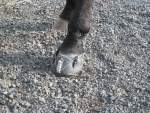
“Not-Remotely-Easy Boot”
River also received doses of bute for the next couple of days, until he stopped limping. We soaked and poulticed for three more days after that, then I no longer needed to soak his hoof, and I could simply infuse gauze with betadine and stuff it into the ever-smaller hole (then duct tape, then Easy Boot) for about two weeks. The treatment was time-consuming and I had to be vigilant about not getting kicked. River is not a “kicky” fellow but he grew tired of having his hoof handled. My total vet bill–including the emergency visit–was nearly $600.
My husband thinks that I was crazy to do all of this, but it’s what it means to own horses. It’s more than just riding. When we came back from the vet that first day, River looked at me as if to say, “You know, you may not be totally useless after all.” For a once-wild mustang who has always been skeptical of people, that was a hearty “Thank you.”
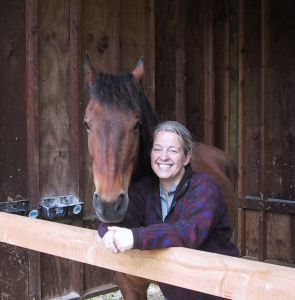
River and Julie

Guest Blog: More Than Just Riding
Julie was one of my go-to people when I was writing about horses for Get Your Pitchfork On!. I remember her trying to decide if her second horse, Laredo, was the right horse; negotiating with his owner; training him and coaxing him to want to obey her. But her first love is River, whom she met nine years ago. They have worked hard together so I knew she was devastated when she posted on Facebook that something was wrong with him. I’m glad everything turned out all right, and she could share this story. She has others on her website.
More Than Just Riding
by Julie Hatfield Jindal
Owning horses is neither easy nor cheap, and definitely not boring. A couple of weeks ago, I stopped by the barn where my two horses live with my friend’s horses. My friend was out of town so I was tossing hay to the herd and checking their water, which takes only a few minutes.
My bay mustang, River, was the last horse to arrive from the pasture, which was unusual. Normally he led the herd. I glanced over to tease him about being lazy, and then I saw why he was so slow. He was holding one of his hind hooves off the ground, limping to the barn on three legs.
No visible wounds, so I took off my gloves to feel his entire leg, but I couldn’t detect any heat or swelling in his joints. He held his leg out to the side, as if his hip were dislocated. My vet’s office had closed five minutes earlier, so I called my other vet, reached his emergency referral service, and left a message for the on-call vet.
Meanwhile, River limped the last fifty feet to his dinner and began to eat. His appetite was a good sign. But the way he held his leg off the ground, his opposite leg quivering with the effort of supporting all the extra weight – I lost it and began to bawl as I imagined the worst. I realized that if I had to put him down that night, I had no idea what I would do with his body.
Two hours later the emergency vet arrived and I was grateful. She suspected a hoof abscess, although she couldn’t locate the entry point for the bacteria in the poor barn lighting, which meant she couldn’t open and drain it. However, she gave him some “bute” (an equine anti-inflammatory) and advised soaking his hoof in Epsom salt.
River and I spent the next morning at the vet’s. I was groggy after two hours of sleep but I doubt River slept much, either. I learned that an abscess is a pocket of infection, and in a horse’s hoof it can become excruciating in less than 24 hours. The buildup of pus and inflammation between a hard hoof and the soft internal tissue makes every step literally unbearable. In River’s case, my vet believed that this summer’s extreme stretch of dry weather, followed by sudden wet weather, created a tiny crack in the “white line” at the base of the hoof which gave bacteria an entry point. Puncture wounds or even stone bruises can also cause abscesses.
Once the entry spot was located, excavated with a knife and then drained (the surprised expression of relief on River’s face was comical), the resulting inch-deep hole had to be kept clean and protected to allow the horse’s physiology to regenerate the sole.
My vet recommended soaking the hoof in Epsom salt water for thirty minutes. A friend loaned me her Soaking Boot (an equine galosh that secures around the ankle) which was a godsend, as River thought that keeping his foot in a bucket of water was a stupid idea. After soaking, per my vet’s instructions, I filled the hole with a poultice of sugar and betadine antiseptic to draw out any remaining infection. I covered the poultice with a square of gauze and duct-taped it into place, with the tape covering the bottom and sides of the hoof, but below the hoof’s hairline. Finally, I latched a device called an Easy Boot (in my case, a Not-Remotely-Easy Boot) onto the hoof and hoped it would stay on. The next day River and I would do it all again.

Soaking boot

“Not-Remotely-Easy Boot”
River also received doses of bute for the next couple of days, until he stopped limping. We soaked and poulticed for three more days after that, then I no longer needed to soak his hoof, and I could simply infuse gauze with betadine and stuff it into the ever-smaller hole (then duct tape, then Easy Boot) for about two weeks. The treatment was time-consuming and I had to be vigilant about not getting kicked. River is not a “kicky” fellow but he grew tired of having his hoof handled. My total vet bill–including the emergency visit–was nearly $600.
My husband thinks that I was crazy to do all of this, but it’s what it means to own horses. It’s more than just riding. When we came back from the vet that first day, River looked at me as if to say, “You know, you may not be totally useless after all.” For a once-wild mustang who has always been skeptical of people, that was a hearty “Thank you.”

River and Julie

October 28, 2012
Condit Dam Revisited
A year ago, I alerted my co-workers at our early morning huddle: I would be in the office but watching the live webcam footage of the breaching of the Condit Dam. They were welcome to join me, but I would be a little distracted. This event verged on religious ceremony as far as I was concerned.
I tuned in around 11:30. There wasn’t much to see yet; the explosives had already been set and there were just a few Pacific Power engineers and Fish & Wildlife people in orange vests and hardhats running around and checking things. A documentarian, Andy Maser, had set up three cameras: one on the west bank, looking down on the basin; one on the east bank, a little lower and closer to the dam; and one on the top of the dam that could rotate to look both up- and down-stream. The feed switched from one camera to the next.
Looking upstream, the camera showed Northwestern Lake lying placid and unsuspecting. Mike and I lived just uphill from it and had canoed on it many times. It was a great lake to paddle around—we passed by floats of cinnamon teals, mallards and any number of other migrating water birds. Wild turkeys and deer gathered at its edges for a drink. If we pulled into one of the fern-covered, cedar-lined coves we might spy an adorable water ouzel, or American dipper, bobbing on a rock next to a waterfall.
Looking downstream, the dry canyon was lined with ferns. A monolith of basalt, probably 30 feet tall, rose in the center about 40 yards from the dam. The usual trickle of run-off flowed from a chute in the dam. Everything seemed to crackle in anticipation. Or, maybe it was just me.
Pacific Power, which owned the 125-foot dam, was not removing it (yet), just blowing a hole in the bottom. They had excavated most of the tunnel, which was about 15 feet across, and this day’s explosion would complete it. The rest of the dam removal would occur in 2012. I knew a bunch of my friends were congregated at a locals’ viewing station up the road, in Husum. There had been 24-hour guard on the dam for weeks to keep out interlopers and The Curious.
I waited.
At noon, there was a series of loud air horn blasts. A flicker called, as if answering them, and then a basso percussion of explosives rumbled. Cement flew from the base of the dam, and right behind it was a black shaft—dense bottom sediment thrust through the tunnel by the pressure of a mile-long reservoir.
It was thrilling. The water seemed to scream with joy. The camera angle switched to the east side camera, which was getting sprayed; droplets slid down the lens. Water rushed past like a speeding locomotive. The camera angle switched to the downstream view: The spike of basalt was being pummeled by the torrent shooting from the dam. I swear it was laughing.
The water was free. I could feel its power from 75 miles away, over an Internet connection and through a camera lens. Even though I would miss canoeing on Northwestern Lake, I was so happy for this river, silenced for 100 years, to get its voice back. I realized tears ran down my cheeks.
I stared, transfixed, for the next hour. The engineers expected the lake to drain in four hours; it took 45 minutes. At first, it didn’t seem like much was happening from the upstream camera, but once the top (the widest, of course) drained it was possible to see the level going down. National Geographic later posted a sped-up view, which seems to me a little like God watching the Creation.
Shortly after the dam was removed, Mike and I drove up to Washington to see everything first hand. To our chagrin, Pacific Power was still guarding the access road to our former canoe put-in. Biologist friends had told us that the put-in was now a deep crevasse, and we would just have to take their word for it because the guard was unmoved by our arguments to let us down there.
Next, we drove to the county park, which is a mile upstream from our old house. With the exception of the deep slice the new river had cut in the east side of the lake bed, the rest was untouched. A mile of perfectly smoothed basalt rocks spread in front of us; we pocketed a few and kept walking. Dead salmon, caught below the dam and released above before the breach, rotted in the rocks. Mike found an old cork handle to a fishing rod.

First salmon above Condit Dam in a century
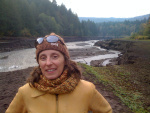
Standing in the middle of the lake
A year later, salmon and steelhead have been seen jumping Husum Falls. A long-time Columbia River Gorge artist, Daniel Dancer, had been part of the effort to remove the dam for decades. His video adds depth to the history; in it, I learned that part of the dam breech included a Native American ceremony, calling the salmon home.
Hearing their voices and drums rise above the roar of the water, I started to cry all over again.

October 21, 2012
I Brake for Gophers
As I drove south on Highway 97 in June, on my way to read from Get Your Pitchfork On! in Bend, a sage rat ran in front of my car. (“Sage rat” usually refers to Belding ground squirrels or gophers.) Without thinking, I braked, carefully and steadily, to let it go by. Then, I laughed.
I guess I’ve been re-citified, I thought.
No country person in their right mind would think twice about running over a ground squirrel. In fact, it’s common practice in southeastern Oregon to go on sage rat hunting expeditions for fun.
A few days later, I drove up Wallowa Loop Road. The road is a barely-two-lane scenic byway through the Wallowa Mountains with sketchy pavement and so many curves I never exceeded 40 miles per hour on the straight-aways. I loved tooling along with the windows down and the dry smell of pine trees filling the car. Butterflies that crossed my path rode the air current over the top of my car without incident.
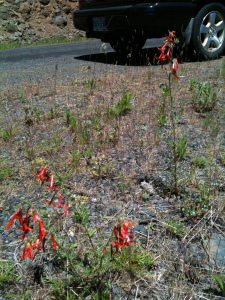
When driving in third gear, you’re more likely to stop along the side of the road to admire the wildflowers
At one point, a local’s pickup came roaring up behind me. How did I know it was a local? No one else would be sporting the enormous “deer-smasher” on his grill nor driving so fast—he’d traversed the road so many times he had it memorized. I pulled over so he could pass in a cloud of gravel and dust, and wondered how many deer he’d actually run into. There a blind corner about every half-mile.
My relationship with animals is complicated. Generally I welcome them, feel protective, even. I love to see antelope or moose grazing on a trail or a nearby hillside, elk or deer at the side of the road, horses and cows in a farmer’s field, woodpeckers and songbirds in my yard. I welcome dogs and cats into my home. I even like skunks!
People I know will go out of their way to run down a snake, gopher, coyote or other critter that happens to find itself on the pavement at the wrong time. I am the opposite, constantly slowing for them. If one fails to get out of the way, which has only happened a couple of times, I wince at the thump and carry a burden of guilt for a while. Thankfully, I’ve never had a large animal dart directly in front of my car.
I am a carnivore but abstain if I can’t be sure that the meat in question came from an animal that was treated and fed well. As documented in a previous post, I do not abide mice in my kitchen. I would never shoot a flicker on the side of my house but I’m not shy about scaring them off, even with warning rocks across the bow. I’ve occasionally thrown rocks at scrub jays simply because they won’t shut up. I vacuum around spiders unless someone is coming to visit; then, I apologize to each one as I unceremoniously suck them up.
Many people who have attended Get Your Pitchfork On! readings have heard the excerpt (published last year by the Jackson Hole Review) about fighting gophers in our garden. It was a learning experience for me, not only in doing the killing but—perhaps more importantly—in preparing emotionally to kill. By the time we left our land, I was still not super-excited about the killing but I sure appreciated the being-dead.
Going out of my way to spare a sage rat in Eastern Oregon showed me that I’ve still got one foot in the country and one in the city.


